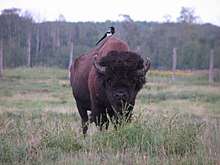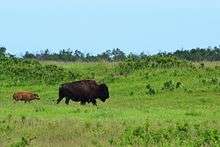Elk Island National Park
Elk Island National Park is in the Edmonton Capital Region of Alberta, Canada, less than an hour's drive east of Edmonton on the Yellowhead Highway, near Vegreville.
Famous as a refuge for grazing animals, the park has the second highest density of hoofed mammals per square area of any region on earth (excepting the Serengeti plains of East Africa). Visitors can see over 40 species of free-roaming mammals including plains bison, wood bison, elk (wapiti), moose, deer, beaver, and muskrat. Over 250 species of birds live here, making it a good place for birdwatching. This is one of the last remaining large areas of natural aspen parkland, one of the most endangered habitats in Canada, that is undisturbed by agriculture and other human activities.
Open year-round, park visitors can enjoy wildlife viewing, hiking, canoeing, kayaking, sailing, cross-country skiing, snowshoeing, golfing, picnicking and overnight camping.
Understand

This is Canada's only entirely fenced national park, and home to Canada's most famous herds of wild bison (aka "buffalo") which are used as breed stock to repopulate other famous parks in Canada (Banff National Park in 2017), the USA (Yellowstone) and even Russia. Elk Island is a small park by Canadian standards at 194 km2 (75 sq mi) and is an "island" (metaphorically, only) of protected of forest surrounded by farmland. Because this is the closest park to the city of Edmonton and located on a major highway (Alberta 16, the "Yellowhead" route of the Trans-Canada Highway), it sees many Canadian visitors but because it lacks photogenic mountain vistas it is a not part of common intentional itineraries of Western Canada, unlike the more famous Banff National Park to the south.
History
Prior to joining Canada in 1870, the Beaver Hills had been an important hunting and trapping area for the indigenous peoples of the area. By the time Canada began inviting Europeans to settle in the area after 1870, however, the region had become "trapped out" of beavers (they were locally extinct due to over-harvesting) because of the commercial demand for beaver pelts in England for making top hats.
The areas on all sides of the park are good farmlands and were part of the general wave of settlement of this part of Alberta during the 1890s. However the park itself is located on rocky, wet land not suited for wheat growing. It was used for grazing, lumber, and hunting by surrounding farmers, but not much tilled.
The Canadian government started a timber reserve here in 1899 to preserve the remaining forests, making this is one of Canada's oldest protected areas.
At first it was only the trees that deemed worth of protection from development but in 1906 the area officially became an elk sanctuary, then a federal park in 1916, and was a founding park of the Canadian national parks system when it began in 1930. The area's claim to fame originated in 1907, when the park was used as a temporary holding area for plains bison. This was a wild herd purchased by the Canadian government in Montana, one of the last such herds in existence. The bison were supposed to be shipped on to another park, but an estimated 40-70 bison evaded recapture, and their decedents have been there ever since.
Woodland bison were thought to be completed extinct (or interbred with plains bison) at one point, but in 1957 a small, genetically pure herd was discovered in Wood Buffalo National Park. Then in 1965, 23 of those woodland bison were moved to Elk Island Park to start a second herd. The two subspecies are kept apart by the fences and highway to maintain genetic purity.
Landscape
The park protects the "Southern Boreal Plains and Plateaus" natural region - a transitional zone between the aspen parkland to the south and the boreal forest to the north. Elk Island National Park has a "knob and kettle" topography rising 30-60 m above the surrounding plains of Alberta.
Elk Island National Park is an island, not in the geographical sense, but in terms of its landscape of small hills and depressions surrounded by flat plains. When the glaciers retreated from the area, they left debris clustered around chunks of ice that formed the knobs, while the melting ice made shallow ponds or kettles. These are eutrophic ponds, meaning they have a very poor oxygen supply, but they contain rich accumulations of nutrients, making them an excellent habitat for plants and wildfowl. The park has more than 250 lakes, ponds and wetlands over 20% of its surface area.
Astotin Lake, near the park's north end is 3.9 km long, almost 3.1 km wide and 0.5-10 metres deep, the park's largest body of water.
Climate
The climate of the area is continental (dry) and temperate (varies by season); the park is usually just a degree or two colder than Edmonton on a typical day.
Flora and Fauna
- See also: North American wildlife

The star attraction here are the two different sub-species of bison (also known as "buffalo"), woodland bison on the south side of the highway, and plains bison on the north. As well there are the eponymous "elk" (a.k.a. wapiti), as well as moose (called "elk" in Europe), deer, coyotes, fishers, lynx, and so on.
Get in
Elk Island National Park is approximately one hour's drive from Edmonton city centre, via Highway 16 East (Yellowhead). It is open 365 days a year.
There is no train, no public bus, and limited taxi/rideshare service outside of Edmonton. This park is mostly for travellers who can drive or are on a chartered coach.
Fees and permits
Daily/Annual (December 1 to March 31)/Annual fees:
- Adult $7.80/$31.40/$39.20
- Senior $6.80/$27.40/$34.30
- Youth and children under 18 free
- Family/group $15.70/$78.50/$78.50
Parks Canada Passes
The Discovery Pass provides unlimited admission for a full year at over 80 Parks Canada places that typically charge a daily entrance fee It provides faster entry and is valid for 12 months from date of purchase. Prices for 2018 (taxes included):
- Family/group (up to 7 people in a vehicle): $136.40
- Children and youth (0-17): free
- Adult (18-64): $67.70
- Senior (65+): $57.90
The Cultural Access Pass: people who have received their Canadian citizenship in the past year can qualify for free entry to some sites.
Get around
See

- 🌍 Ukrainian Cultural Heritage Village, Highway 16 (25 minutes east of Edmonton, and 3 km east of the National Park entrance), ☎ +1 780 662-3855. Daily May long weekend to Labour Day (early Sep), 10AM–5PM. This award-winning provincial historic site showcases Ukrainian settlement in East Central Alberta. There are over 30 historic buildings including three churches, a fully-functioning grain elevator, blacksmith shop, and sod hut, all enlivened by costumed interpreters. Weekends are busier, however the crowds can be worth it with more interpreters on hand and often more things going on. Adult (18-64) $15, senior (65+) $13, youth (7-17) $10, child (0-6) free, Canadian military and family (with CFOne card) free, Family (2 adults + youths, maximum of 8 people) $40.
Do
Buy, eat and drink
The only retail store in the park is in the visitor's centre near the south park gate, it only sells souvenirs, not food or camping equipment. Everything else available in nearby Sherwood Park (the west), Lamont (to the north), or Mundare to the east.
Sleep
During the summer, the park offers a semi-serviced campground. Hotels, motels, bed & breakfasts, gasoline, groceries, and other services, are available in communities surrounding the park.
- Park campsite, ☎ +1 450-505-8302, +1-866-787-6221 (TTY), toll-free: +1-877-RESERVE (7373783) (12 hours/day).
Stay safe
. Safety for visitors:
- Safety first - view wildlife from a safe distance and vantage point.
- Remain in your vehicle to view wildlife on roadways.
- Slow down when wildlife are near the roadside.
- Observe the 60 km/h speed limit on the Elk Island Parkway.
- At all times, maintain a distance of 100 metres from moose, elk, deer and bison.
Visitors are discouraged from bicycling on park trails in wet spring weather conditions and during the rut (breeding season for ungulates) from late July through to the autumn.
- Become familiar with the natural hazards of the park, be properly equipped, and well prepared (knowledge, skills, fitness) for wildlife viewing activities such as hiking, walking, and cross-country skiing.
- Report aggressive wildlife to Parks Canada staff. Check with Parks Canada staff for information and safety warnings. Respect area and trail closures. Trails and areas are occasionally closed due to aggressive wildlife, poor trail conditions, on-going management activity, or other hazards. Entering a closed area is an offence under the National Parks General Regulations.
Safety for the wildlife:
- Do not feed the wildlife. Poor health and premature death can result from wildlife consuming food other than their natural food supply. It is forbidden to feed, touch, or attract wild animals with food or bait.
- Resist the temptation to pick wildflowers, cattails, berries, mushrooms, or any other plant item. Plant matter and natural objects such as antlers and bones are part of the natural food supply for wildlife.
- Dogs and other domestic animals must be kept leashed and under physical control at all times when in a national park. Loose domestic animals present a hazard to wildlife, as they are prone to chase and molest wildlife; they also present a public safety hazard.
- It is an offence to lure, disturb, chase or molest wildlife in a national park; penalties can range as high as $5000 or six months in jail.
Go next
| Routes through Elk Island National Park |
| Edmonton ← Sherwood Park ← | W |
→ Vegreville → Saskatoon |